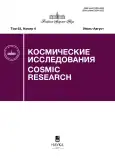Neutron emission from the moon during the historic Carrington solar particle event of September 1, 1859
- Authors: Mitrofanov I.G.1, Sanin A.S.1, Litvak M.L.1, Golovin D.V.1, Djachkova M.V.1, Anikin A.A.1, Lukyanov N.V.1
-
Affiliations:
- Space Research Institute of the Russian Academy of Sciences
- Issue: Vol 63, No 4 (2025)
- Pages: 377-384
- Section: Articles
- URL: https://journal-vniispk.ru/0023-4206/article/view/318399
- DOI: https://doi.org/10.31857/S0023420625040031
- EDN: https://elibrary.ru/qnjydy
- ID: 318399
Cite item
Abstract
The neutron radiation of the lunar surface under the influence of energetic charged particle flux from the intense Solar Proton Event (SPE) is considered. Numerical estimates of the neutron flux and the corresponding neutron component of the radiation dose are made for the historical Carrington SPE, which can be considered an example of the most intense SPE recorded in the modern period of solar activity observations. It is shown that the neutron component of the dose during the Carrington SPE was approximately 1000 times higher than the background value from the impact of Galactic cosmic rays (GCR) on the lunar surface under quiet Sun conditions. The value of the total radiation dose on the lunar surface during the Carrington SPE was close to the limit values for humans in space.
About the authors
I. G. Mitrofanov
Space Research Institute of the Russian Academy of Sciences
Email: golovin@np.cosmos.ru
Moscow, Russia
A. S. Sanin
Space Research Institute of the Russian Academy of Sciences
Email: golovin@np.cosmos.ru
Moscow, Russia
M. L. Litvak
Space Research Institute of the Russian Academy of Sciences
Email: golovin@np.cosmos.ru
Moscow, Russia
D. V. Golovin
Space Research Institute of the Russian Academy of Sciences
Email: golovin@np.cosmos.ru
Moscow, Russia
M. V. Djachkova
Space Research Institute of the Russian Academy of Sciences
Email: golovin@np.cosmos.ru
Moscow, Russia
A. A. Anikin
Space Research Institute of the Russian Academy of Sciences
Email: golovin@np.cosmos.ru
Moscow, Russia
N. V. Lukyanov
Space Research Institute of the Russian Academy of Sciences
Author for correspondence.
Email: golovin@np.cosmos.ru
Moscow, Russia
References
- Drake D.M., Feldman W.C., Jakosky B.M.Martian neutron leakage spectra // J. Geophys. Res. 1988. V. 93. Iss. B6. P. 6353–6368. https://doi.org/10.1029/JB093iB06p06353
- Masarik J., Reedy R. Gamma ray production and transport in Mars // J. Geophys. Res.: Planets. 1996. V. 101. Iss. E8. P. 18891–18912. https://doi.org/10.1029/96JE01563
- Sanin A.B., Mitrofanov I.G., Litvak M.L. et al. Hydrogen distribution in the lunar polar regions // Icarus. 2017. V. 283. P. 20–30.
- Colaprete A., Schultz P., Heldmann J. et al.Detection of water in the LCROSS ejecta plume // Science. 2010. V. 330. P. 463–468.
- Lawrence D.J., Peplowski P.N., Wilson J.T. et al.Global hydrogen abundances on the lunar surface // J. Geophysical Research: Planets. 2022. V. 127. Art.ID e2022JE007197. https://doi.org/10.1029/2022JE007197
- Borg L.E., Connelly J.N., Boyet M. et al.Chronological evidence that the Moon is either young or did not have a global magma ocean // Nature. 2011. V. 477. P. 70-72.
- Usoskin I.G., Gil A., Kovaltsov G.A. et al. Heliospheric modulation of cosmic rays during the neutron monitor era: Calibration using PAMELA data for 2006–2010 / J. Geophys. Res. Space Physics. 2017. V. 122. P. 3875–3887. doi: 10.1002/2016JA023819.
- Kusano K., Iju T., Bamba Yu. et al. A physics-based method that can predict imminent large solar flares // Science. 2020. V. 369. P. 587–591. https://doi.org/10.1126/science.aaz2511
- Митрофанов И.Г., Санин А.Б., Литвак М.Л.и др. Нейтронное излучение лунной поверхности на полюсах // Косм. исслед. 2024. Т. 62. №6. С. 663–672.
- Townsend L.W., Zapp E.N., Stephens D.L. et al. Carrington flare of 1859 as a prototypical worst-case solar energetic particle event // IEEE Trans.Nucl. Sci. 2003. V. 5(6). |Art.ID. 2307e2309.
- Allison J., Amako K., Apostolakis J. et al. Recent developments in GEANT4 // Nuclear Instruments and Methods in Physics Research. 2016. V. 835. P. 186–225.
- Miroshnichenko L.I., Nymmik R.A. Extreme fluxes in solar energetic particle events: Methodological and physical limitations // Radiation Measurements. 2014. V. 61. P. 6–15. https://doi.org/10.1016/j.radmeas.2013.11.010
- Usoskin I.G., Gil A., Kovaltsov G.A. et al. Heliospheric modulation of cosmic rays during the neutron monitor era: Calibration using PAMELA data for 2006–2010 // J. Geophys. Res. Space Physics. 2017. V. 122. P. 3875–3887. doi: 10.1002/2016JA023819.
- Dietze G., Bartlett D., Cool D. et al.ICRP Publication 123: Assessment of Radiation Exposure of Astronauts in Space // Annals of the ICRP. 2013. V. 42(4). P. 1–339. doi: 10.1016/j.icrp.2013.05.004.
- Dobynde M., Guo J.Guidelines for radiation-safe human activities on the Moon // Nature. Astronomy. 2024. V. 8. P. 991–999.
- Limitation of Astronaut’s Exposure During Near-Earth Space Flights, Methodical Recommendations Report MR-17.01-2001 (in Russian) (Roscosmos, 2021).
- NASA Space Flight Human-System Standard. V. 1, Revision b: Crew health 1. 67 p. (NASA, 2022).
- Мокроусов М.И., Митрофанов И.Г., Аникин А.А.и др. Второй этап космического эксперимента “БТН Нейтрон” на борту российского сегмента Международнойкосмической станции: аппаратура БТН-М2 // Косм. исслед. 2022. Т. 60. №5. С. 426–436.
- Brehm N., Christl M., Knowles T.D.J. et al.Tree-rings reveal two strong solar proton events in 7176 and 5259 BCE // Nature Communications. 2022. V. 13. Art.ID. 1196. https://doi.org/10.1038/s41467-022-28804-9
- Uusitalo J., Golubenko K., Arppe L. et al.Transient offset in 14C after the Carrington event recorded by polar tree rings // Geophysical Research Letters. 2024. V. 51. Art.ID. e2023GL106632. https://doi.org/10.1029/2023GL106632
Supplementary files









